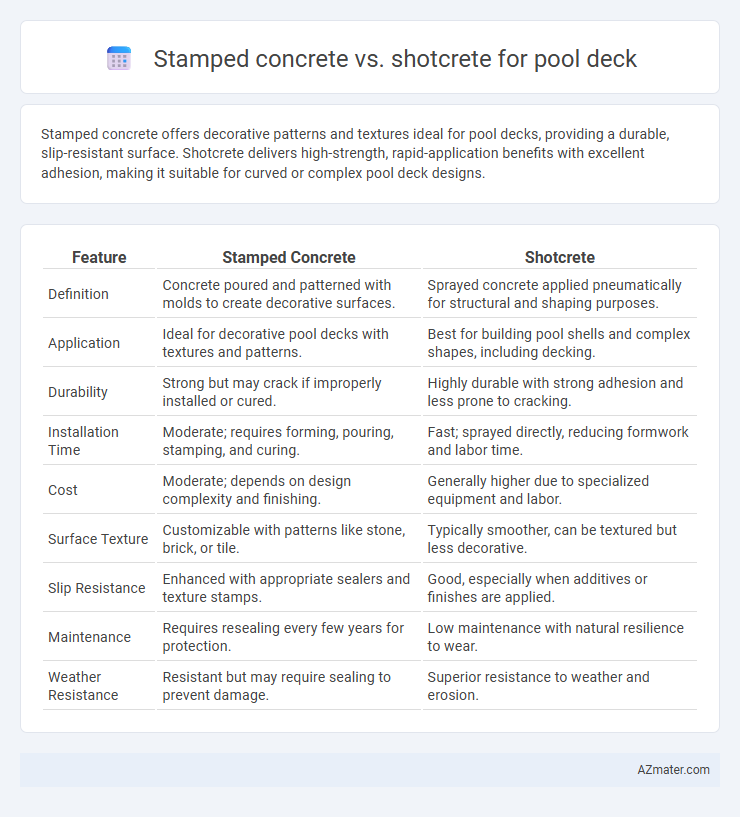Stamped concrete offers decorative patterns and textures ideal for pool decks, providing a durable, slip-resistant surface. Shotcrete delivers high-strength, rapid-application benefits with excellent adhesion, making it suitable for curved or complex pool deck designs.
Table of Comparison
| Feature | Stamped Concrete | Shotcrete |
|---|---|---|
| Definition | Concrete poured and patterned with molds to create decorative surfaces. | Sprayed concrete applied pneumatically for structural and shaping purposes. |
| Application | Ideal for decorative pool decks with textures and patterns. | Best for building pool shells and complex shapes, including decking. |
| Durability | Strong but may crack if improperly installed or cured. | Highly durable with strong adhesion and less prone to cracking. |
| Installation Time | Moderate; requires forming, pouring, stamping, and curing. | Fast; sprayed directly, reducing formwork and labor time. |
| Cost | Moderate; depends on design complexity and finishing. | Generally higher due to specialized equipment and labor. |
| Surface Texture | Customizable with patterns like stone, brick, or tile. | Typically smoother, can be textured but less decorative. |
| Slip Resistance | Enhanced with appropriate sealers and texture stamps. | Good, especially when additives or finishes are applied. |
| Maintenance | Requires resealing every few years for protection. | Low maintenance with natural resilience to wear. |
| Weather Resistance | Resistant but may require sealing to prevent damage. | Superior resistance to weather and erosion. |
Introduction: Comparing Stamped Concrete and Shotcrete for Pool Decks
Stamped concrete offers decorative patterns and textures that mimic natural stone or brick, enhancing the aesthetic appeal of pool decks while providing durability and slip resistance. Shotcrete, a pneumatically applied concrete, delivers superior structural strength and faster application, making it ideal for complex shapes and reinforced pool decks. Both methods ensure long-lasting surfaces, but choice depends on design preferences, budget, and specific project requirements.
What is Stamped Concrete?
Stamped concrete is a decorative concrete technique that involves imprinting patterns and textures onto freshly poured concrete to resemble materials such as stone, brick, or tile, commonly used for pool decks. It offers a durable, customizable surface that enhances the aesthetic appeal and slip resistance around pools. In contrast to shotcrete, which is sprayed concrete typically used for structural applications, stamped concrete prioritizes design and surface finish.
Understanding Shotcrete in Pool Deck Construction
Shotcrete, a method of spraying concrete at high velocity, provides superior adhesion and strength for pool deck construction compared to traditional poured concrete. Its ability to form complex shapes and contours with minimal formwork makes it ideal for custom pool decks, especially those requiring curved surfaces or intricate designs. The enhanced durability and reduced permeability of shotcrete result in a longer-lasting, low-maintenance pool deck that withstands harsh weather and heavy foot traffic.
Aesthetic Options: Patterns and Finishes
Stamped concrete offers a wide range of aesthetic options for pool decks, including intricate patterns such as cobblestone, slate, and brick, combined with customizable color finishes that mimic natural materials. Shotcrete provides a more uniform surface ideal for smooth, curved pool decks but has limited pattern and texture variations compared to stamped concrete. The choice between stamped concrete and shotcrete depends on whether the priority is elaborate design versatility or a seamless, durable finish.
Durability and Longevity Analysis
Stamped concrete offers excellent durability for pool decks with its dense, reinforced surface resistant to cracking and weathering, typically lasting 25-30 years when properly maintained. Shotcrete, applied pneumatically, provides superior strength and longevity due to its dense, bond-enhancing compaction, often exceeding 30 years in durability under consistent exposure to pool chemicals and freeze-thaw cycles. Both materials require sealing and routine care, but shotcrete's enhanced structural integrity makes it more resilient against long-term environmental stress and heavy foot traffic around pools.
Installation Process and Timeframe
Stamped concrete requires form setting, pouring, and imprinting patterns before curing, typically taking 3 to 5 days for installation and preliminary curing. Shotcrete is sprayed pneumatically onto rebar framework, allowing faster application and structural shaping, often completing installation within 1 to 3 days. The quicker setting of shotcrete reduces overall project time, while stamped concrete demands additional finishing and curing periods for optimal durability.
Cost Comparison: Stamped Concrete vs. Shotcrete
Stamped concrete for pool decks typically costs between $8 to $18 per square foot, including materials and labor, offering a decorative finish at a moderate price. Shotcrete, while also used for pool decks, generally involves higher expenses ranging from $15 to $25 per square foot due to its specialized application process and superior strength. Budget considerations often favor stamped concrete for aesthetic enhancement, whereas shotcrete commands a premium for durability and structural integrity.
Maintenance Requirements and Upkeep
Stamped concrete pool decks require regular sealing every 2-3 years to prevent cracking and color fading, while shotcrete needs occasional surface cleaning and minor patching due to its durability. Maintenance for stamped concrete involves monitoring for surface wear from UV exposure and chemical spills, whereas shotcrete's dense composition resists water infiltration and minimizes long-term repairs. Choosing shotcrete reduces frequent upkeep costs but may involve higher initial installation compared to the more decorative yet maintenance-intensive stamped concrete.
Safety and Slip-Resistance Features
Stamped concrete offers enhanced slip-resistance due to its textured surface, making pool decks safer by reducing the risk of slips and falls. Shotcrete, while durable and quick to apply, often requires additional surface treatment to achieve comparable slip-resistance. Choosing stamped concrete can improve pool deck safety with its customizable anti-slip patterns and finishes designed specifically for wet environments.
Which Is Better for Your Pool Deck?
Stamped concrete offers intricate patterns and colors that mimic natural stone, providing an aesthetically pleasing and customizable pool deck surface. Shotcrete, delivered via high-pressure spraying, excels in structural strength and durability, making it ideal for complex shapes and uneven terrains around the pool. For decorative appeal and versatility, stamped concrete is preferable, while shotcrete is better suited for robust, long-lasting pool deck foundations.

Infographic: Stamped concrete vs Shotcrete for Pool deck
 azmater.com
azmater.com